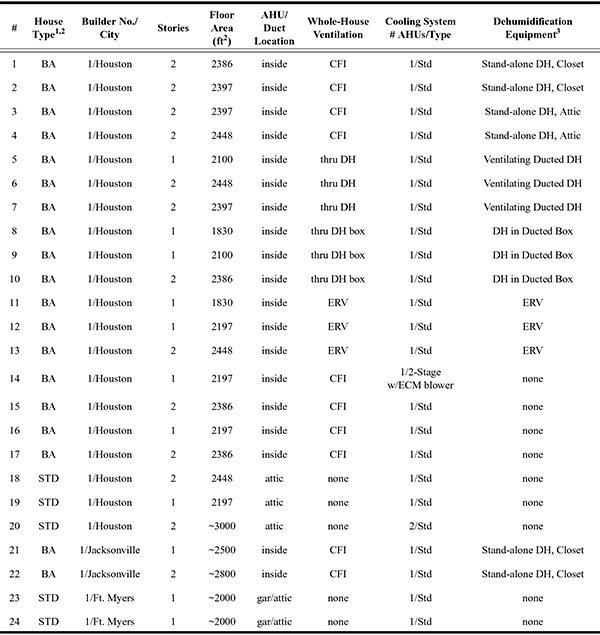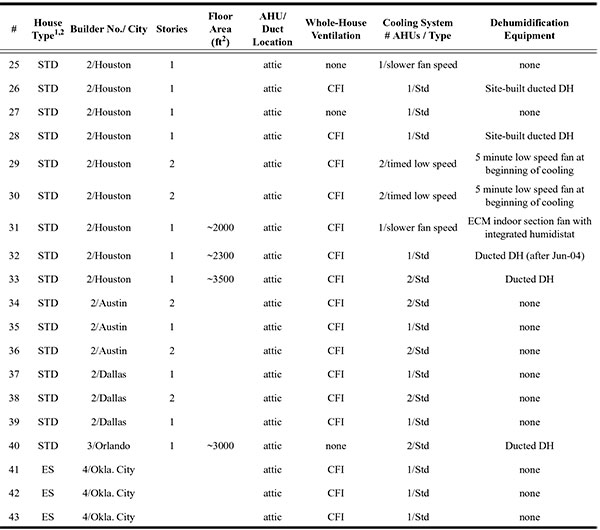A range of house and mechanical system types were evaluated, including standard building enclosures and cooling systems and high-performance building envelopes with enhanced cooling or supplemental dehumidification systems. Indoor humidity levels were found to be highest in high-performance, low sensible heat gain homes with mechanical ventilation. These homes often require a separate dehumidifier to maintain space humidity in the swing seasons and at night when the thermostat is satisfied. The use of supplemental dehumidification in a high-performance house enables the implementation of efficiency improvements that significantly reduce sensible cooling demand while still maintaining proper humidity levels.
Introduction
The overall goal of the USDOE Building America residential research program is to reduce average whole house energy use in new residential buildings from 30% to 90% by 2020, including homes that achieve zero net energy use on an annual basis. High-performance air-conditioning equipment and control systems that match the high performance of Building America envelopes are necessary to meet these energy performance targets. Conditioning systems with integrated mechanical ventilation and year-round temperature and humidity control are a prerequisite.
Common improvement measures used to achieve highperformance building goals generally affect the sensible cooling load far more than the latent cooling load. For example, adding insulation, low solar gain windows, Energy Star® appliances, and fluorescent lighting all reduce heat gain to the conditioned space but do nothing to reduce the latent (moisture) gain. In hot-humid climates, reducing building air leakage and duct leakage (or moving ducts inside the conditioned space) has a large beneficial effect on reducing the latent and sensible cooling load. While the benefit of air tightening is significant, there is a limit to the benefit if year-round mechanical ventilation is used to meet ASHRAE 62.2 requirements (ASHRAE 2004a).
Modeling has pointed to the problem of maintaining indoor relative humidity in residences below 60% all year in humid climates (Trowbridge et al. 1994). Testing of highperformance homes over the last few years has shown that adequate humidity control is difficult to achieve throughout the year without supplemental dehumidification (Rudd et al. 2005). Conventional cooling equipment is capable of meeting the sensible and latent loads—and maintaining acceptable humidity levels—at design conditions (i.e., hottest times of the day). However, high humidity levels are typically observed at part-load conditions when sensible cooling loads are modest or nonexistent. At these times, moisture loads due to internal gains and ventilation remain high even though the sensible loads go to zero, and comfort control may not be achieved (Henderson et al. 1992). High-performance homes have greatly reduced sensible loads in the space, further exacerbating this problem. In many cases, latent loads occur at times when no sensible cooling is required (i.e., the thermostat is satisfied). Humidity control during these periods requires dehumidification that can be provided separate from sensible cooling. Conventional cooling equipment is not well suited to meeting these loads.
Most cooling equipment needs to operate for at least 10 to 15 minutes at a time to begin to operate efficiently and remove much moisture (Shirey and Henderson 2004). Typical oversizing compounds the indoor moisture control problem by causing short on-time cycles (ACCA 2004). Several types of space-conditioning equipment and control enhancements have been proposed and used to address the need for better part-load dehumidification.
Several equipment manufacturers offer equipment with enhanced moisture removal at part load. These systems typically vary blower speed, operate at lower compressor stages, or lower cooling setpoints to provide more dehumidification. The increasing use of variable-speed fan motors, lower-cost humidity sensors, and embedded electronic controls in higher-end cooling systems have made these control approaches practical. Typical control algorithms lower airflow at low-load conditions to reduce coil temperatures and provide more moisture removal (Krakow et al. 1995; Andrade and Bullard 2002). While these enhanced control approaches can increase the proportion of total cooling capacity that is provided as latent, they do not allow moisture removal to be provided separately from sensible cooling.
Stand-alone dehumidifier appliances are widely available to meet latent loads and provide humidity control. These systems add sensible heat to the space as they remove moisture, which some may perceive as inefficient. These stand-alone appliances can dehumidify a room but can only indirectly provide whole-house dehumidification, assuming distribution is accomplished via operation of the central air distribution system. To address this concern, some manufacturers are now offering ducted dehumidifiers to provide better air distribution throughout the house.
Enthalpy recovery ventilation units temper incoming ventilation air. They cannot strictly dehumidify a space, but can lessen the incoming ventilation load by exchanging heat and moisture between the exhaust and ventilation airstreams. This equipment has the greatest effect at times when the outdoor enthalpy is high. At part-load conditions, enthalpy exchangers have little moisture control effect, since the dew point of the incoming ventilation air can only approach (but not be lower than) the space dew point.
This paper presents measured space humidity data from a variety of standard and high-performance homes that use conventional cooling equipment as well as the types of HVAC systems mentioned above. The results confirm that humidity is usually maintained below 60% RH at design or peak load conditions. However, high humidity typically occurs at part-load conditions when sensible cooling loads are low or nonexistent. This paper seeks to understand and explain the effect that building envelope performance and HVAC system configuration had on humidity levels in these homes.
Study Approach
To better understand moisture control dynamics in homes, indoor temperature and humidity data were collected from several test houses as part of the USDOE Building America Program. Data were collected at 43 houses from May 2000 through February 2005. The houses are located in various climate regions, including the hot-humid cities of Houston, Austin, Dallas, Jacksonville, Fort Meyers, and Orlando, as well as less humid areas such as Oklahoma City.
The data set included “high-performance” houses that were designed and built to Building America standards as well as standard houses that were monitored to establish a baseline. Some of the houses included enhanced air conditioners, dehumidifiers, or energy recovery ventilators (ERVs). Most houses also included an explicit means to deliver ventilation air to the space.
Battery-powered temperature and relative humidity dataloggers were placed in various locations in the conditioned space and attic at each home. At some sites, additional dataloggers were installed to record the runtime or status of the cooling, heating, dehumidification, and ventilation systems. All dataloggers were programmed to collect data at hourly intervals. Data collection continued for periods ranging from several months to over a year at each site.
The data collected from the test homes were analyzed to understand when and why high humidity occurs. The analysis also evaluates how closely high humidity and the need for dehumidification correspond to cooling operation.
House and System Characteristics
The study includes three types of building envelopes:
- standard-performance design (e.g., standard builder practice)
- medium-performance design (e.g., Energy Star® home)
- high-performance design (e.g., Building America)
Table 1: Description of Homes — Builder 1

Notes:
- Homes 1-17, 21-22 are high-performance with unvented/conditioned attic, ducts in conditioned space, roof insulation, shingle roof. (Home 22 has vented attic, BUT with ducts in conditioned space.)
- Homes 18-20, 23-24 are std-performance with vented attic, ducts in attic, ceiling insulation, shingle roof 18-20, tile roof 23-24
- Stand-alone dehumidifiers are 50 pint/day (23.7 L/day) units.
Table 2: Description of Homes — Builders 2, 3, 4

Notes:
- Homes 25-40 are all std-performance with vented attic, ceiling insulation, ducts in attic, shingle roof.
- Homes 41-43 are all medium-performance Energy Star homes with vented attic, ceiling insulation, ducts in attic, shingle roof.
Tables 1 and 2 summarize the characteristics of the tested homes and their HVAC systems. The homes identified as STD in the tables are standard home designs, while the high-performance Building America or Energy Star® designs are identified with BA and ES, respectively. The high-performance Building America homes were built to an airtightness standard of 0.25 cfm/ft2 (1.27 L/s⋅m2) of building enclosure area at 0.20 in. w.c. (50 Pa) (pressure differential (same as 2.5 in.2 of equivalent leakage area per 100 ft2 of building enclosure area [1.74 cm2/m2]). The standard houses typically had at least 50% more leakage and the medium-performance houses were generally in between. As is becoming more commonplace, the builders of all the houses understood the importance of duct . . .
Download complete document here.
